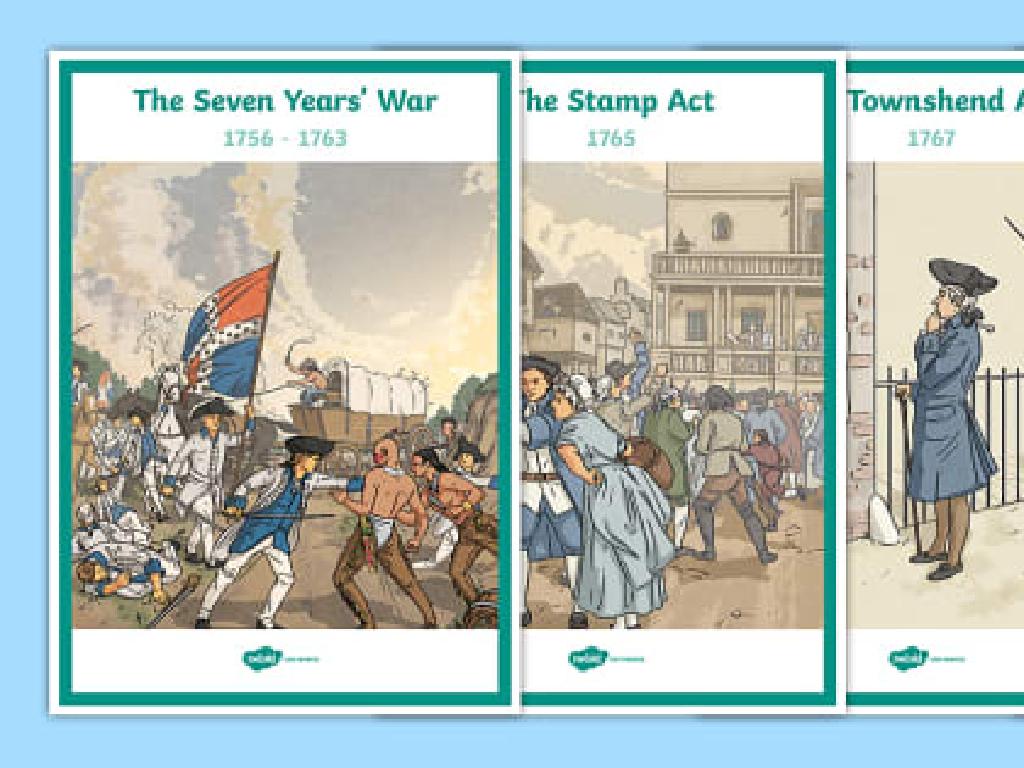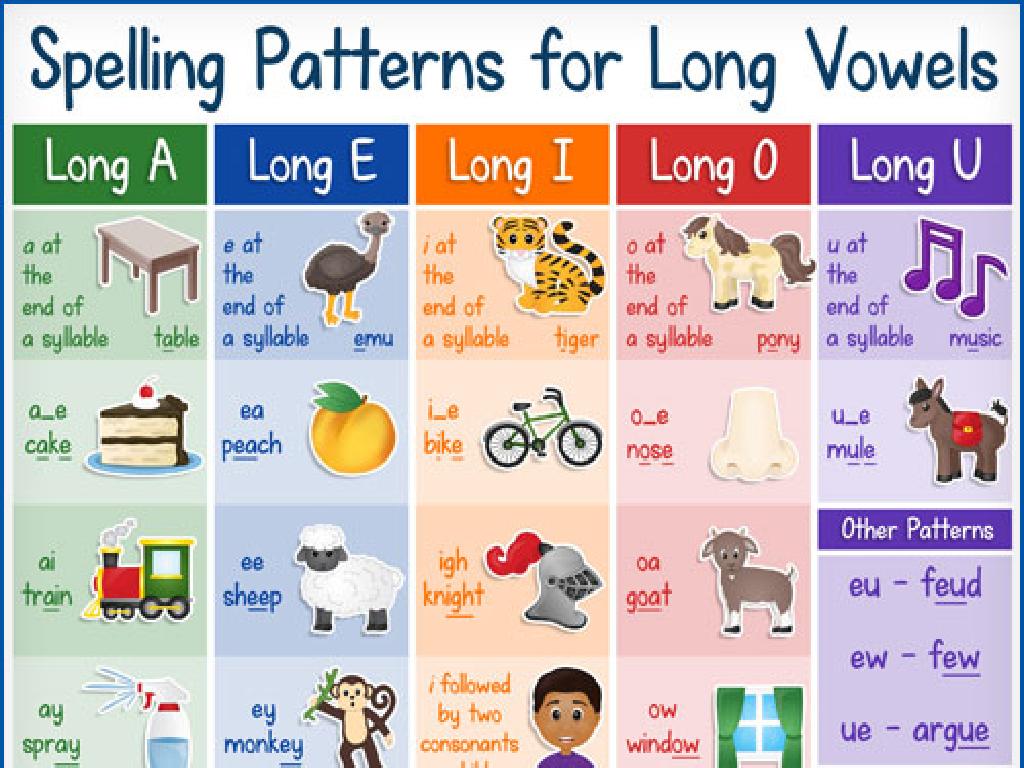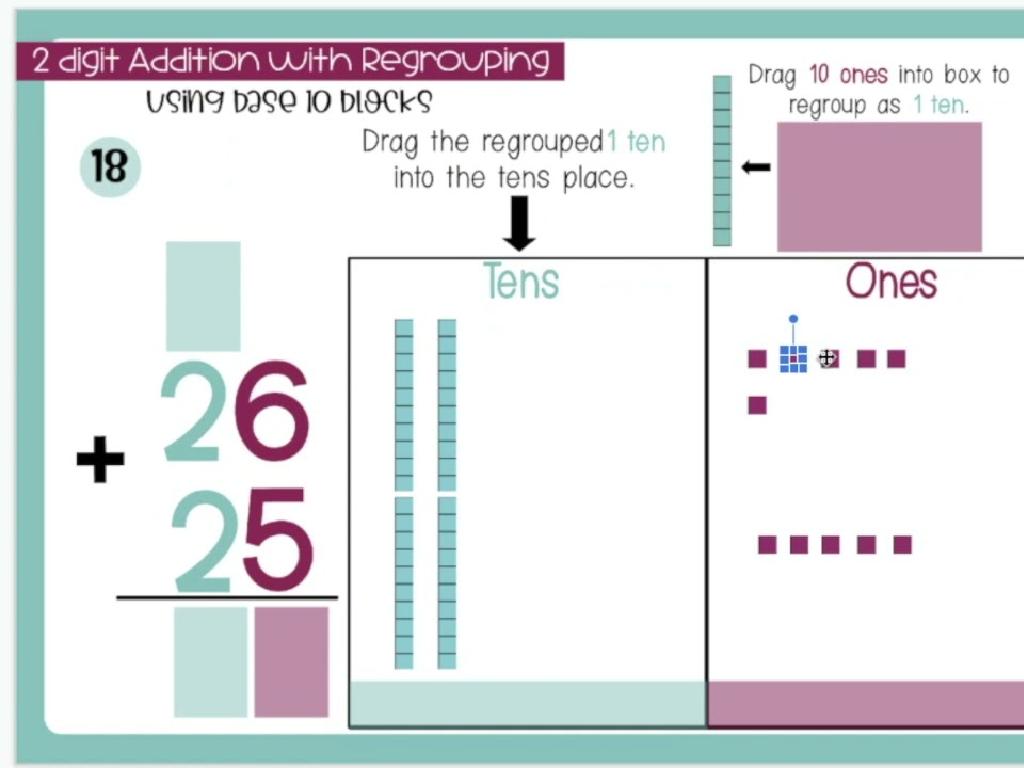Compare And Convert Customary Units Of Length
Subject: Math
Grade: Fourth grade
Topic: Customary Units Of Measurement
Please LOG IN to download the presentation. Access is available to registered users only.
View More Content
Exploring Customary Units of Length
– Learn customary length units
– Units like inches and feet measure length
– Inches, feet, yards, and miles
– 12 inches in a foot, 3 feet in a yard, 5280 feet in a mile
– Everyday use of length units
– Measure height, distance, or objects around us
– Practice with real examples
– Use a ruler or tape measure to find lengths of items in class
|
This slide introduces students to the customary units of length commonly used in the United States. Start by explaining each unit: inches, feet, yards, and miles, and how they are related (e.g., 12 inches in a foot). Discuss with students how these units are used in everyday life, such as measuring their height, the length of a room, or the distance to a friend’s house. Encourage students to think of examples where they have used or heard these units being used. As an activity, students can bring in items from home to measure in class, or measure objects in the classroom, to apply their understanding of these units in a practical context.
Understanding Inches and Feet
– What is an inch? Use a ruler
– An inch is a small unit of length. Look at the small marks on a ruler!
– A foot equals 12 inches
– A foot is a larger unit. It’s the same as 12 of those small inch marks!
– Examples: Measure in inches and feet
– Inches: Pencil length. Feet: Your textbook’s height.
– Practice: Find items to measure
– Let’s measure your desk’s width in inches and feet.
|
This slide introduces students to the basic units of length in the customary system. Start by explaining what an inch is, using a ruler for a visual representation. Then, describe a foot as a unit of length that is equivalent to 12 inches, again using a ruler for demonstration. Provide relatable examples of items that are typically measured in inches and feet, such as a pencil or a textbook. Finally, engage the students with a hands-on activity where they find items in the classroom to measure using both inches and feet to reinforce the concept. This practical application will help solidify their understanding of comparing and converting between these two units of length.
Feet and Yards: Measuring Length
– Understanding yards and feet
– 1 yard equals 3 feet
– Use a yardstick to visualize and measure
– Real-world length examples
– Fabric is often sold by the yard; playgrounds and football fields are measured in yards and feet
– Using a yardstick
– Practice measuring objects at home or in class with a yardstick
|
This slide is aimed at helping fourth-grade students understand the relationship between feet and yards, which are customary units of length. Start by explaining that 1 yard is equal to 3 feet. Use a yardstick during the lesson to give students a tangible sense of what a yard looks like. Provide relatable examples such as lengths of fabric, the size of playgrounds, and the dimensions of football fields to illustrate the use of yards and feet in real life. Encourage students to bring a yardstick to class and measure various items to reinforce their understanding. The activity will help solidify the concept of converting between feet and yards through practical application.
Yards and Miles: Measuring Distance
– What is a mile?
– Yards in a mile
– 1 mile equals 1760 yards
– Race distances
– Track events often measured in yards or miles
– City to city
– Comparing the distance from one city to another in miles
|
This slide aims to help students understand the relationship between yards and miles, which are both customary units of length. Begin by explaining that a mile is a longer unit of measurement used to measure greater distances, such as the length of a race or the distance between cities. Clarify that there are 1760 yards in a mile. Provide examples such as the length of common races (e.g., a 5K race is approximately 3.1 miles) and the distance between nearby cities or landmarks. Encourage students to think of distances they are familiar with and how those might be measured in both yards and miles. This will help them grasp the concept of converting between these two units of measurement.
Mastering Length Conversion
– Memorize simple conversion tricks
– Like 12 inches equals 1 foot, or 3 feet equals 1 yard
– Use multiplication/division to convert
– Multiply to convert to a larger unit, divide for a smaller unit
– Conversion chart practice problems
– Solve problems using a chart to convert between inches, feet, yards
|
This slide aims to equip students with handy tricks and methods for converting between different customary units of length. Start by introducing mnemonic devices or simple tricks to help them remember basic conversions, such as ’12 inches in a foot’ and ‘3 feet in a yard.’ Explain how multiplication can be used to convert to larger units (e.g., feet to yards), and division for smaller units (e.g., inches to feet). Provide a conversion chart and practice problems to reinforce these concepts. Encourage students to work through the problems during class and offer assistance as needed. This will help solidify their understanding of length conversion in a practical way.
Comparing Lengths in Customary Units
– Understanding length comparison
– Compare lengths by using a ruler to measure.
– Using comparison symbols
– Symbols: > (greater), < (less), = (equal).
– Practice arranging lengths
– Order lengths: 3 in, 5 in, 2 ft, 1 yd.
|
This slide introduces students to the concept of comparing different lengths using customary units such as inches (in), feet (ft), and yards (yd). Start by explaining how to measure lengths using a ruler and then introduce the comparison symbols greater than, less than, and equal to. For the practice activity, students will arrange given lengths from shortest to longest, reinforcing their understanding of both measurement and comparison. Ensure that students grasp the concept of unit conversion, as they will need to know that 12 inches make a foot and 3 feet make a yard to accurately compare lengths. This activity will help solidify their understanding of length comparison in a practical context.
Estimation with Customary Units
– Why estimation is useful
Estimation helps us make quick, reasonable guesses.
– Estimating everyday objects
Guess the length of a pencil, book, or desk in inches or feet.
– Classroom estimation activity
Choose classroom items to estimate and then measure.
– Measuring after estimating
|
This slide introduces the concept of estimation within the context of customary units of length. Estimation is a valuable skill that allows students to make educated guesses about length without measuring. It’s useful in everyday situations where precise measurements are not necessary. Start by discussing why estimation is important and where it can be applied in real life. Then, move on to a class activity where students will estimate the length of various objects around the classroom, such as a pencil, a book, or a desk, using inches, feet, or yards. After making their estimates, they will use rulers or measuring tapes to measure the actual length of the items. This exercise will help them understand the practicality of estimation and improve their ability to judge the size of objects. Provide guidance on how to estimate lengths and ensure that each student has an opportunity to participate in the activity.
Class Activity: Conversion Relay
– Split into teams for a relay
– Each team measures set objects
– Use rulers or measuring tapes
– Convert measurements
– Change inches to feet, or feet to yards
– First to finish correctly wins
|
This activity is designed to make learning about customary units of length fun and interactive. Divide the class into small teams, providing each with a set of objects to measure. They will use rulers or measuring tapes to find the length of each item in inches, then convert those measurements to feet or yards. The first team to correctly measure and convert all their items wins. Prepare a variety of objects of different lengths to make the game more challenging. Possible activities for different teams could include measuring classroom items, personal items, or estimating and then measuring to check accuracy. This will help students understand practical applications of measurement and conversion.





